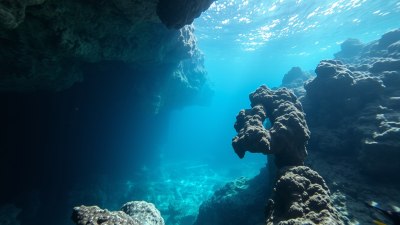Exploring the Underwater Caves of Mexico
Discover the breathtaking underwater caves of Mexico, a diver's paradise filled with stunning formations and rich history.

Image created with Flux Schnell
Mexico is renowned for its vibrant culture, stunning beaches, and rich history, but beneath the surface lies a breathtaking world that few get to experience. The underwater caves of Mexico offer an extraordinary adventure for divers and explorers alike. Among the world's largest and most impressive cave systems, these underwater marvels showcase nature's artistry while providing insight into ancient civilizations and geological wonders. We will explore their formation, significance, diving experiences, and the importance of preservation.
The Formation of Underwater Caves
Underwater caves, known as 'cenotes' in Mexico, are a product of millions of years of natural processes. The Yucatán Peninsula, where many of these caves exist, is primarily composed of limestone. Over time, rainwater, slightly acidic from carbon dioxide in the atmosphere, seeps through the ground, gradually eroding the limestone and creating vast underground networks. This process, known as karst topography, results in incredible geological formations that include stalactites, stalagmites, and expansive underwater chambers.
The cenotes often have exposed sinkholes that provide access to both air-filled chambers and submerged tunnels. These caves can be interconnected, creating an extensive system for exploration. Some famous cenotes are the Dos Ojos, Gran Cenote, and Cenote Ik Kil, each offering a unique underwater experience.
The Historical Significance of Cenotes
Cenotes held great significance for the ancient Mayans, who considered them sacred. They believed that cenotes were entrances to the underworld and offered sacrifices to appease their gods. Artifacts including pottery, human remains, and offerings have been discovered in many cenotes, reflecting their importance in Mayan culture. Today, they serve as both archaeological sites and popular diving locations that provide insight into the rich history of this ancient civilization.
Additionally, these underwater caves have been vital for water supply. During the dry season, they were often used as a source of fresh water, making them essential for the survival of the Mayan people and their communities. The connection between the cenotes and ancient civilizations adds an enchanting layer to their exploration, combining adventure with history.
Diving in the Underwater Caves
For divers, Mexico's underwater caves offer a unique experience, combining thrill and beauty. Divers can explore crystal-clear waters that reveal breathtaking underwater formations, from intricate stalactites to stunning rock formations. The visibility in these caves can often exceed 30 meters, making it a diver's paradise where light dances through the water and illuminates the landscape.
The dos Ojos Cave System is one of the most popular spots for divers and offers more than 60 km of underwater tunnels. Divers can traverse through various passages, witnessing flora and fauna that thrive in these unique ecosystems. Safely exploring these caves requires special training and certification due to the intricate nature of cavern diving. It is important to have experience with buoyancy control and navigation to avoid dangerous situations while diving.
Many dive schools in the region provide training and guided tours for both novice and experienced divers. These schools emphasize safety and environmental awareness, providing equipment and local expertise to enhance the diving experience. Beyond just the thrill of diving, participants learn about the ecology and geology of the caves, deepening their appreciation for these natural wonders.
The Aquatic Life in Cenotes
The underwater caves of Mexico are not just geological wonders; they are also ecological sanctuaries. The cenotes host a variety of aquatic life, playing a significant role in the region's biodiversity. Fish, crustaceans, and other marine organisms thrive in these waters, adapting to the unique conditions of the cave environment. Species such as the Mexican blind cavefish have evolved without sight, showcasing nature’s incredible adaptability in these isolated ecosystems.
Cenotes also serve as a crucial habitat for many species, providing spawning grounds and shelter. The presence of unique flora and fauna emphasizes the importance of these underwater caves beyond their recreational value. As such, diving in these environments fosters a sense of responsibility amongst divers and encourages conservation efforts to protect these fragile ecosystems.
Conservation and Preservation Efforts
While the underwater caves of Mexico attract divers from around the globe, they face numerous challenges posed by tourism and pollution. Increased recreational use can lead to damaging impacts on delicate ecosystems. In response, many organizations are working to raise awareness about the importance of preserving these natural wonders. Initiatives focus on creating sustainable tourism practices, educating divers about environmental responsibility, and advocating for protective policies.
Visitors are encouraged to participate in self-regulation by following established guidelines, such as not touching cave formations, avoiding the use of oils or sunscreens before diving, and maintaining buoyancy to protect delicate ecosystems. Local governments and NGOs also play critical roles in safeguarding these sites against environmental threats.
Local Communities and Education
The underwater caves are also vital to local communities that rely on tourism for their livelihood. Eco-friendly tourism has emerged as a vital economic force, providing opportunities for guides, dive operators, and those involved in related industries. Education and awareness programs can benefit these communities by highlighting the ecological and cultural significance of cenotes and engaging them in sustainable practices.
By fostering appreciation and understanding of the underwater caves, local residents become stewards of these natural resources, ensuring their protection for future generations to enjoy. Such community involvement is key to preserving the caves while still benefiting from responsible tourism.
The underwater caves of Mexico represent a hidden world rich with geological wonder and historical significance. From their formation and importance to the Mayans, to the exhilarating experience of diving, these cenotes provide a unique glimpse into nature's spectacular artistry. As we venture into the depths of the earth, we must remember the significance of conservation and the need to preserve these treasures. By doing so, we not only protect the unique ecosystems but also honor the cultural heritage and history tied to these magnificent underwater caves. Whether you’re an adventurer seeking your next thrill, a history enthusiast delving into ancient civilizations, or simply a lover of nature, Mexico's underwater caves offer something for everyone—a chance to explore, connect, and appreciate the world beneath the waves.











